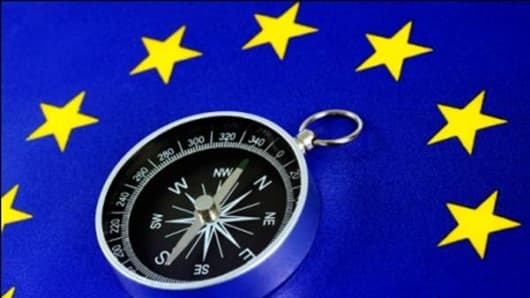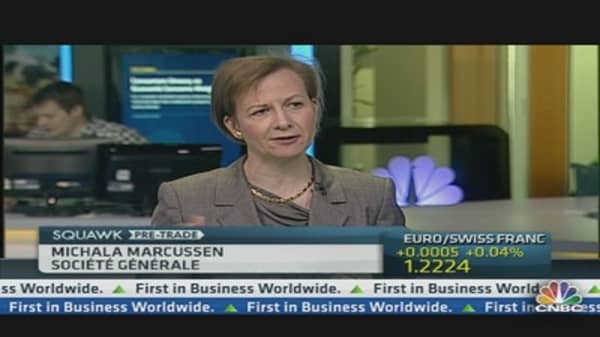(Read More: Why ECB's 'Super Mario' Could Struggle Without Luigi)
There has also been ongoing speculation the ECB could cut its deposit rate, turning it negative from its current level of zero, but that is not seen as likely.
"Draghi, in his comments, could easily intimate that disinflation story, that they're taking note. I would have thought if anything, he's going to err on the more dovish side. It's hard to see this in any way being euro positive," Ruskin said.
Euro zone inflation eased to 1.2 percent in April, the lowest level since February, 2010, and below the ECB's target 2 percent rate. Unemployment in the euro zone is also at a record 12.1 percent, with 19.2 million people out of work, the highest level since the single currency was created in 1999.
Weak employment data also continues to worry U.S. markets. The ADP private sector payroll number for April was reported at 119,000 Wednesday, about 30,000 less than expected. That hurt sentiment as traders viewed it as a warning that the April jobs report could be weaker than expected Friday, after March's surprisingly low 88,000 nonfarm payrolls. According to Reuters, economists expect 145,000 nonfarm payrolls in Friday's announcement.
Stocks sold off into the Fed's 2 p.m. ET announcement Wednesday, and continued to sell off into the close. The Dow lost nearly a percent, falling 138 points to 14,700, while the S&P lost 14, to 1582, after closing at an all-time high the day earlier. Both indexes had their worst first trading day of any month since June, 2012 and worst Fed day since Sept. 21, 2011.
"The market has thrown off the softening economic data because of Central Bankers, and finally today and tomorrow everything is out on the table from Central Banks," said one trader. "I think we're just approaching one of those 'sell on the news moments' and the fact that all this Central Bank action is only creating inflated asset prices and nothing else"
The ECB and Fed actions highlight the focus of global central banks on easing, as the world economy sputters along. The Bank of Japan has also embarked on a massive easing program, announcing 7.5 trillion yen in monthly debt purchases.
(Read More: Why an ECB Rate Cut Could Be Too Little, Too Late)
"The call (to ease) is a higher calling in the eyes of policy makers. They want to make sure they see us through this mess. The fact we're still in these easing programs means the coast is not clear. It doesn't mean we have to have a repeat of 2008," said Goncalves. "The stock market is very resilient. It's been operating for many reasons higher than where it should be due to debt, buybacks, you name it." The S&P 500 is up nearly 11 percent, year-to-date.
Treasurys saw buying ahead of the Fed's afternoon statement, driving the 10-year yield to 1.61 percent, the lowest level since December, but after the meeting it moved back up to 1.63 percent. Some traders are concerned about what the low Treasury rate is signaling at a time when stock prices are near record levels. "That should alarm people in equities," a trader said.
Goncalves said he expects the 10-year yield to dip to as low as 1.5 percent in coming weeks.
He said many investors bet wrong on the idea that when stocks go up, Treasurys go down. "I think that's been the widow-maker for this year. Both a stock rally and then bonds sell off was the wrong trade. If we were to see a stock pullback, it's hard to see a bond sell off either. It really means Treasurys stay lower for longer," he said.
What Else to Wach
There are also earnings from Cigna, Kellogg, Cardinal Health, CME Group, Churchand Dwight, Manulife Financial, Goldcorp, International Paper, Foster Wheeler,Plains Exploration, Marsh and McLennan, MGM Resorts, Beazer Homes, Western Refining, and PG&E, ahead of the market open. AIG and Kraft report after the closing bell.






